MongoDB3.6 一键化自动部署方案
1.系统基础配置
下面的命令默认都使用root用户进行操作,操作系统为Centos7,mongodb3.6.x以上版本
1.1 修改系统配置文件/etc/security/limits.conf和/etc/profile
修改/etc/security/limits.conf持久化设置允许用户/进程打开文件句柄数,这一步需要重启系统,不然不起作用
* soft nofile 1048576
* hard nofile 1048576
* soft nproc 524288
* hard nproc 524288
修改/etc/profile,在最后添加ulimit -s 1024,然后保存并source /etc/profile
1.2 关闭每台机器的防火墙
Centos7以下命令:
chkconfig iptables off && service iptables stop

使用命令查看chkconfig --list 是否设置自动启动为关闭

Centos7以上命令:
systemctl stop firewalld

systemctl is-enabled firewalld

1.3 每台机器修改/etc/hosts和hostname
在/etc/hosts添加集群所有的ip及对应的hostname
注意:配置的ip数与选择的模板相关联

1.4 机器之间配置ssh免密登录
每台机器分别执行下面命令,这里以5台机器为准:
ssh-keygen -t rsa -P "" -f /root/.ssh/id_rsa
ssh-copy-id node1
ssh-copy-id node2
ssh-copy-id node3
ssh-copy-id node4
ssh-copy-id node5
1.5 检测自动化部署所需的命令是否可用
ifconfig、ssh需要可用
需要安装numactl,使用rpm -qa | grep numactl查看numactl是否已安装
注意:完成上面5步操作后重启每台机器。重启完毕,使用命令ulimit -a 查看
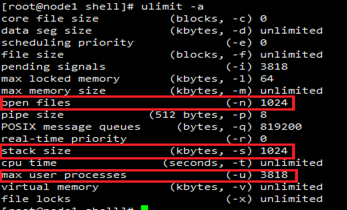
要保证 open files 对应的值为 1048576
Stack size 对应的值为1024
Max user processes对应的值为 524288
1.6 检查mongodb安装下bin目录和shell目录执行权限
进入到shell目录,执行chmod +x auto*加执行权限
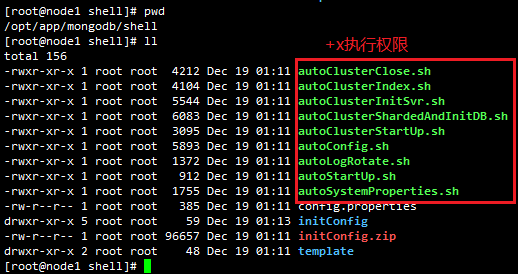
进入mongodb的bin目录,执行chmod +x ./*加执行权限
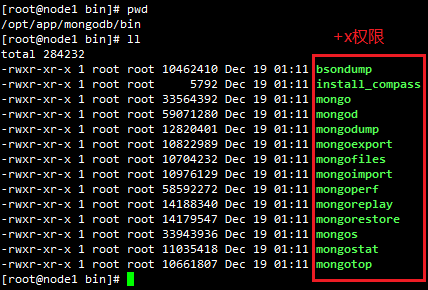
2.MongoDB 一键化部署
2.1 一键化部署shell文件介绍
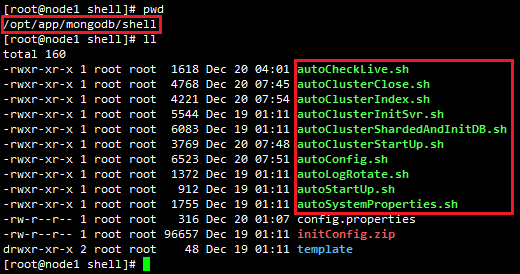
shell脚本文件目前放置在mongodb的安装目录下:
⑪config.properties,配置文件,包括mongodb安装目录、mongoCluster集群安装目录、所需主机、数据库等等。如图:
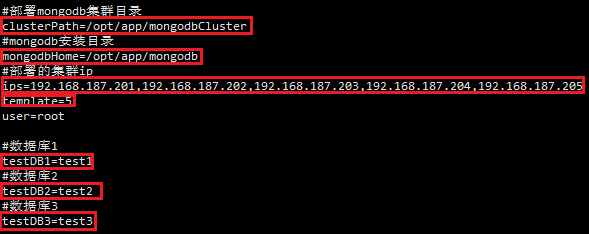
上图几个参数可能需要随环境不同而修改。
说明:
ips=192.168.187.201, 192.168.187.202, 192.168.187.203, 192.168.187.204, 192.168.187.205
这里默认192.168.187.201为mongdb集群的节点node1,192.168.187.202为mongdb集群的节点node2,192.168.187.203为mongdb集群的节点node3,192.168.187.204为mongdb集群的节点node4,,192.168.187.205为mongdb集群的节点node5。
template与ips的ip数量对应,ips的ip数为5,则意味着采用5台机器的模板,这里默认为5。
⑬template 目录包括3.conf、4.conf和5.conf,为mongodb3台机器、4台机器和5台机器安装模板,有需要者可以自行修改模板。
3.conf 3台机器分配的mongodb节点模板为
#所有mongo节点
nodes=config,shard1,shard2,shard3,mongos
#机器分配到的mongo节点
node1=mongos,config,shard1,shard2,shard3
node2=mongos,config,shard1,shard2,shard3
node3=mongos,config,shard1,shard2,shard3
#mongo节点分配到的机器,注意shard部分排在第一的为master,第二为secondary,第三位arbitery
config=node1,node2,node3
mongos=node1,node2,node3
shard1=node1,node2,node3
shard2=node2,node3,node1
shard3=node3,node2,node1
#mongo节点端口
config_port=29040
mongos_port=29050
shard1_port=29010
shard2_port=29020
shard3_port=29030
注意:这里的node1、node2、node3不是机器hostname(当然也可以以这种node1、node2方式去命名hostname),只是机器ip的代名称,因为不同开发环境中的ip总是不同的,所以使用node1、node2...去代替变化的ip。这里的node1、node2、node3默认与config.properties中的ips属性对应,即ips中的第一个ip默认为node1,第二个ip默认为node2,第三个ip默认为node3,4.conf和5.conf类同。查看下图,可以清晰看到mongodb分布的节点:
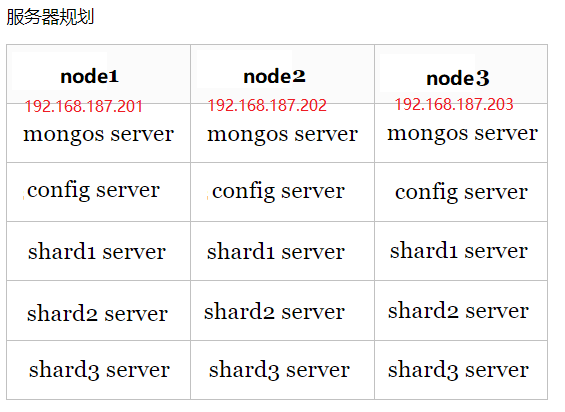
4.conf 4台机器分配mongodb节点的模版为
#所有mongo节点
nodes=config,shard1,shard2,shard3,shard4,mongos
#机器分配到的mongo节点
node1=mongos,shard1,shard3,shard4
node2=mongos,config,shard1,shard2,shard4
node3=mongos,config,shard1,shard2,shard3
node4=config,shard2,shard3,shard4
#mongo节点分配到的机器,注意shard部分排在第一的为master,第二为secondary,第三位arbitery
config=node2,node3,node4
mongos=node1,node2,node3
shard1=node1,node2,node3
shard2=node2,node3,node4
shard3=node3,node4,node1
shard4=node4,node1,node2
#mongo节点端口
config_port=29040
mongos_port=29050
shard1_port=29000
shard2_port=29010
shard3_port=29020
shard4_port=29030
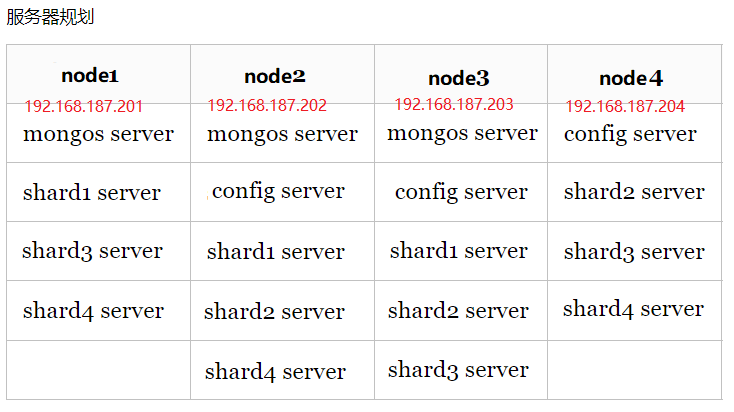
5.conf 5台机器分配mongodb节点的模版为
#所有mongo节点
nodes=config,shard1,shard2,shard3,shard4,shard5,mongos
#机器分配到的mongo节点
node1=mongos,shard1,shard4,shard5
node2=mongos,shard1,shard2,shard5
node3=config,shard1,shard2,shard3
node4=config,shard2,shard3,shard4
node5=config,shard3,shard4,shard5
#mongo节点分配到的机器, 注意shard部分排在第一的为master,第二为secondary,第三位arbitery
config=node3,node4,node5
mongos=node1,node2
shard1=node1,node2,node3
shard2=node2,node3,node4
shard3=node3,node4,node5
shard4=node4,node5,node1
shard5=node5,node1,node2
#mongo节点端口
config_port=29040
mongos_port=29050
shard1_port=29060
shard2_port=29070
shard3_port=29080
shard4_port=29090
shard5_port=29100

模板需要配置的几项内容:
- mongodb所有节点
- 每台机器分配的mongodb节点
- 每个mongodb节点分配的机器
- mongo节点的端口
如有需要,可自行配置6、7或者更多的机器分配mongo模板
①autoCheckLive.sh脚本为创建所在服务器对应的mongodb的进程存活监控,不存在则自动拉起。
#! /bin/bash #shell目录的绝对路径 shellPath=$1 configPath=$shellPath/config.properties #从config.properties文件读取数据出来 clusterPath=`awk -F= -v k=clusterPath '{ if ( $1 == k ) print $2; }' $configPath` template=`awk -F= -v k=template '{ if ( $1 == k ) print $2; }' $configPath` templatePath=$shellPath/template/$template.conf ips=`awk -F= -v k=ips '{ if ( $1 == k ) print $2; }' $configPath` #ip数组 eval $(echo $ips | awk '{split($0, arr, ","); for(i in arr) print "ipArray["i"]="arr[i]}') #本地ip localIp=`/sbin/ifconfig -a|grep inet|grep -v 127.0.0.1|grep -v inet6 | awk '{print $2}' | tr -d "addr:"` suffix="" #判断linux系统cpu是否为numa架构,如果是则传回_numa,禁用numactl numaCount=`grep -i numa /var/log/dmesg | wc -l` nodeCount=`grep -i numa /var/log/dmesg | grep -wi "node" | wc -l` offCount=`grep -i numa /var/log/dmesg | grep -wi "numa=off" | wc -l` if [[ ($numaCount -gt 1) && ($nodeCount -gt 1) && ($offCount -eq 0) ]] then suffix="_numa" fi #遍历ip数组 for((i=1; i<=${#ipArray[@]}; i++)) do #获取本地ip在模板中的代称号,根据本地ip所在ip数组中的下标数字获取 if [[ $localIp = ${ipArray[i]} ]] then #获取模板中本地ip对应的代称号所拥有的mongo节点 mongodbNodes=`awk -F= -v k=node$i '{ if ( $1 == k ) print $2; }' $templatePath` eval $(echo $mongodbNodes | awk '{split($0, mongodbArr, ","); for(y in mongodbArr) print "mongodbArray["y"]="mongodbArr[y]}') for n in ${mongodbArray[*]} do pid=`cat $clusterPath/$n/pid/$n.pid` #判断是否存活 count=`ps -ef | grep $pid | grep -v grep | wc -l` #程序挂掉啦,启动 if [ $count -eq 0 ];then cd $shellPath && $shellPath/autoStartUp.sh $n$suffix fi done fi done
②autoClusterClose.sh脚本为mongodb集群关闭脚本,用法:./autoClusterClose.sh shutdown或者./autoClusterClose.sh kill,这里建议使用shutdown方式关闭。
#! /bin/bash configPath=config.properties #mongodb的安装目录 mongodb_home=`awk -F= -v k=mongodbHome '{ if ( $1 == k ) print $2; }' $configPath` #mongodb集群安装目录 clusterPath=`awk -F= -v k=clusterPath '{ if ( $1 == k ) print $2; }' $configPath` #所采用的安装模板 template=`awk -F= -v k=template '{ if ( $1 == k ) print $2; }' $configPath` #模板所在的位置 templatePath=template/$template.conf user=`awk -F= -v k=user '{ if ( $1 == k ) print $2; }' $configPath` localIp=`/sbin/ifconfig -a|grep inet|grep -v 127.0.0.1|grep -v inet6 | awk '{print $2}' | tr -d "addr:"` ips=`awk -F= -v k=ips '{ if ( $1 == k ) print $2; }' $configPath` eval $(echo $ips | awk '{split($0, arr, ","); for(i in arr) print "ipArray["i"]="arr[i]}') #获取所有的配置、路由、分片 nodes=`awk -F= -v k=nodes '{ if ( $1 == k ) print $2; }' $templatePath` eval $(echo $nodes | awk '{split($0, nodeArr, ","); for(i in nodeArr) print "nodeArray["i"]="nodeArr[i]}') #查看/etc/crontab是否开启定时任务,有则关闭 for((i=1; i<=${#ipArray[@]}; i++)) do if [[ $localIp = ${ipArray[i]} ]] then #kill本地的mongod、mongos echo "*****close ${ipArray[i]} 定时任务:日志切割和mongo进程存活监控*****" $mongodb_home/shell/autoConfig.sh removeCronTask else echo "*****close ${ipArray[i]} 定时任务:日志切割和mongo进程存活监控*****" ssh $user@${ipArray[i]} "cd $mongodb_home/shell && $mongodb_home/shell/autoConfig.sh removeCronTask" fi done if [[ $1 = "kill" ]] then for((i=1; i<=${#ipArray[@]}; i++)) do if [[ $localIp = ${ipArray[i]} ]] then #kill本地的mongod、mongos echo "*****close ${ipArray[i]} mongodb*****" ps -ef | grep $clusterPath/conf | grep -v grep | cut -c 9-15 | xargs kill -2 else echo "*****close ${ipArray[i]} mongodb*****" ssh $user@${ipArray[i]} "ps -ef | grep $clusterPath/conf | grep -v grep | cut -c 9-15 | xargs kill -2" fi done fi if [[ $1 = "shutdown" ]] then #1.先关闭mongos #找到mongos对应的机器节点 mongoss=`awk -F= -v k=mongos '{ if ( $1 == k ) print $2; }' $templatePath` eval $(echo $mongoss | awk '{split($0, mongosArr, ","); for(i in mongosArr) print "mongosArray["i"]="mongosArr[i]}') for mongosNode in ${mongosArray[*]} do #删除node,保留右边字符。下面两句是根据机器节点的代名称数字找到其对应的ip mongosIpNum=${mongosNode#*node} mongosIp=${ipArray[$mongosIpNum]} if [[ $localIp = $mongosIp ]] then echo "****************close $mongosIp mongos****************" ps -ef | grep $clusterPath/conf/mongos.conf | grep -v grep | cut -c 9-15 | xargs kill -2 else echo "****************close $mongosIp mongos****************" ssh $user@$mongosIp "ps -ef | grep $clusterPath/conf/mongos.conf | grep -v grep | cut -c 9-15 | xargs kill -2" fi done #2.再关闭configs configs=`awk -F= -v k=config '{ if ( $1 == k ) print $2; }' $templatePath` eval $(echo $configs | awk '{split($0, configArr, ","); for(i in configArr) print "configArray["i"]="configArr[i]}') #副本集,先关闭仲裁节点、从节点,最后关闭主节点 for((i=${#configArray[@]}; i>=1; i--)) do configNode=${configArray[i]} #删除node,保留右边字符 configIpNum=${configNode#*node} configIp=${ipArray[$configIpNum]} if [[ $localIp = $configIp ]] then echo "****************close $configIp config****************" $mongodb_home/bin/mongod -f $clusterPath/conf/config.conf --shutdown else echo "****************close $configIp config****************" ssh $user@$configIp "$mongodb_home/bin/mongod -f $clusterPath/conf/config.conf --shutdown" fi done #3.最后关闭shards for node in ${nodeArray[*]} do if [[ $node =~ "shard" ]] then shards=`awk -F= -v k=$node '{ if ( $1 == k ) print $2; }' $templatePath` eval $(echo $shards | awk '{split($0, shardArr, ","); for(i in shardArr) print "shardArray["i"]="shardArr[i]}') #副本集,先关闭仲裁节点、从节点,最后关闭主节点 for((i=${#shardArray[@]}; i>=1; i--)) do shardNode=${shardArray[i]} #删除node,保留右边字符 shardIpNum=${shardNode#*node} shardIp=${ipArray[$shardIpNum]} if [[ $localIp = $shardIp ]] then echo "****************close $shardIp $node****************" $mongodb_home/bin/mongod -f $clusterPath/conf/$node.conf --shutdown else echo "****************close $shardIp $node****************" ssh $user@$shardIp "$mongodb_home/bin/mongod -f $clusterPath/conf/$node.conf --shutdown" fi done fi done fi
③autoClusterIndex.sh脚本为mongodb集群初始化配置文件和修改系统配置、config和shard副本集以及mongos路由启动并初始化、mongodb集群数据库表分片和基础数据初始化的脚本、添加定时任务。用法:./ autoClusterIndex.sh。使用该脚本,可以全自动化安装mongodb。
#! /bin/bash configPath=config.properties #从config.properties文件读取数据出来 clusterPath=`awk -F= -v k=clusterPath '{ if ( $1 == k ) print $2; }' $configPath` mongodb_home=`awk -F= -v k=mongodbHome '{ if ( $1 == k ) print $2; }' $configPath` ips=`awk -F= -v k=ips '{ if ( $1 == k ) print $2; }' $configPath` localIp=`/sbin/ifconfig -a|grep inet|grep -v 127.0.0.1|grep -v inet6 | awk '{print $2}' | tr -d "addr:"` user=`awk -F= -v k=user '{ if ( $1 == k ) print $2; }' $configPath` template=`awk -F= -v k=template '{ if ( $1 == k ) print $2; }' $configPath` templatePath=template/$template.conf #获取所有的配置、路由、分片 nodes=`awk -F= -v k=nodes '{ if ( $1 == k ) print $2; }' $templatePath` eval $(echo $nodes | awk '{split($0, nodeArr, ","); for(i in nodeArr) print "nodeArray["i"]="nodeArr[i]}') eval $(echo $ips | awk '{split($0, arr, ","); for(i in arr) print "ipArray["i"]="arr[i]}') #遍历ip数组 for((i=1; i<=${#ipArray[@]}; i++)) do if [[ $localIp = ${ipArray[i]} ]] then #1.创建mongodbCluster并修改系统配置 echo "********************************start ${ipArray[i]} autoConfig && autoSystemProperties********************************" $mongodb_home/shell/autoConfig.sh && $mongodb_home/shell/autoSystemProperties.sh else #把远程服务器旧的mongodb安装包删除 ssh $user@${ipArray[i]} "rm -rf $mongodb_home" #把mongodb安装包拷贝到远程服务器 scp -r $mongodb_home $user@${ipArray[i]}:$mongodb_home echo "********************************start ${ipArray[i]} autoConfig && autoSystemProperties********************************" ssh $user@${ipArray[i]} "cd $mongodb_home/shell && $mongodb_home/shell/autoConfig.sh && $mongodb_home/shell/autoSystemProperties.sh" fi done #2.mongodb集群启动config、shard1、shard2、shard3 echo "********************************start mongodb集群启动config、shard1、shard2、shard3********************************" #不启动mongos,只启动config,shards $mongodb_home/shell/autoClusterStartUp.sh notmongos #3.mongodb集群配置、分片的副本集初始化 echo "********************************start mongodb集群分片和副本集初始化********************************" $mongodb_home/shell/autoClusterInitSvr.sh cs #4.mongodb集群启动mongos echo "********************************start mongodb集群mongos********************************" mongoss=`awk -F= -v k=mongos '{ if ( $1 == k ) print $2; }' $templatePath` eval $(echo $mongoss | awk '{split($0, mongosArr, ","); for(i in mongosArr) print "mongosArray["i"]="mongosArr[i]}') for mongosNode in ${mongosArray[*]} do #删除node,保留右边字符 mongosIpNum=${mongosNode#*node} mongosIp=${ipArray[$mongosIpNum]} if [[ $localIp = $mongosIp ]] then echo "****************start $mongosIp mongos****************" $mongodb_home/shell/autoStartUp.sh mongos else echo "****************start $mongosIp mongos****************" ssh $user@$mongosIp "cd $mongodb_home/shell && ./autoStartUp.sh mongos" fi done #5.mongodb集群mongos初始化 echo "********************************start mongodb集群mongos初始化********************************" $mongodb_home/shell/autoClusterInitSvr.sh mongos #6.mongodb集群数据库表分片和初始化 echo "********************************start mongodb集群数据库表分片和初始化********************************" $mongodb_home/shell/autoClusterShardedAndInitDB.sh #7.mongodb集群配置定时任务:日志每天切割,保留7天日志/每隔10分钟监控mongo进程是否存活,不存活则自动拉起 for((i=1; i<=${#ipArray[@]}; i++)) do if [[ $localIp = ${ipArray[i]} ]] then echo "******************************** ${ipArray[i]} 添加定时任务:日志切割和mongo存活监控 ********************************" $mongodb_home/shell/autoConfig.sh addCronTask else echo "******************************** ${ipArray[i]} 添加定时任务:日志切割和mongo存活监控 ********************************" ssh $user@${ipArray[i]} "cd $mongodb_home/shell && $mongodb_home/shell/autoConfig.sh addCronTask" fi done
④autoClusterInitSvr.sh脚本为mongodb集群config、shard和mongos初始化脚本。用法:./autoClusterInitSvr.sh cs,初始化config和shard副本集配置;./autoClusterInitSvr.sh mongos,初始化mongos路由配置。
#! /bin/bash configPath=config.properties mongodb_home=`awk -F= -v k=mongodbHome '{ if ( $1 == k ) print $2; }' $configPath` template=`awk -F= -v k=template '{ if ( $1 == k ) print $2; }' $configPath` templatePath=template/$template.conf ips=`awk -F= -v k=ips '{ if ( $1 == k ) print $2; }' $configPath` eval $(echo $ips | awk '{split($0, arr, ","); for(i in arr) print "ipArray["i"]="arr[i]}') #获取所有的配置、路由、分片 nodes=`awk -F= -v k=nodes '{ if ( $1 == k ) print $2; }' $templatePath` eval $(echo $nodes | awk '{split($0, nodeArr, ","); for(i in nodeArr) print "nodeArray["i"]="nodeArr[i]}') param=$1 if [[ $param = "cs" ]] then #自动化设置配置副本集 config_numbers="" ccount=0 config_port=`awk -F= -v k=config_port '{ if ( $1 == k ) print $2; }' $templatePath` configs=`awk -F= -v k=config '{ if ( $1 == k ) print $2; }' $templatePath` eval $(echo $configs | awk '{split($0, configArr, ","); for(i in configArr) print "configArray["i"]="configArr[i]}') configMasterNode=${configArray[1]} echo "configMasterNode: $configMasterNode" #删除node,保留右边字符 configMasterIpNum=${configMasterNode#*node} #echo "configMasterIpNum: $configMasterIpNum" configMasterIp=${ipArray[$configMasterIpNum]} #echo "configMasterIp: $configMasterIp" for((i=1; i<=${#configArray[@]}; i++)) do configNode=${configArray[i]} #删除node,保留右边字符 configIpNum=${configNode#*node} config_numbers=$config_numbers"{_id : $ccount, host : '${ipArray[$configIpNum]}:$config_port'}," ccount=`expr $ccount + 1` done #删除最后一个,保留左边字符 echo "********************************设置config副本集********************************" config_numbers=${config_numbers%,*} echo $config_numbers $mongodb_home/bin/mongo $configMasterIp:$config_port/admin << EOF config = {_id : "configs", members : [ $config_numbers ] }; rs.initiate(config); EOF #自动化设置分片shard副本集 for node in ${nodeArray[*]} do if [[ $node =~ "shard" ]] then shard_numbers="" shardMasterIp="" scount=0 shard_port=`awk -F= -v k=$node"_port" '{ if ( $1 == k ) print $2; }' $templatePath` shards=`awk -F= -v k=$node '{ if ( $1 == k ) print $2; }' $templatePath` eval $(echo $shards | awk '{split($0, shardArr, ","); for(i in shardArr) print "shardArray["i"]="shardArr[i]}') for((i=1; i<=${#shardArray[@]}; i++)) do shardNode=${shardArray[i]} #echo "shardNode: $shardNode" #删除node,保留右边字符 shardIpNum=${shardNode#*node} #echo "shardIpNum: $shardIpNum" if [[ $scount = 0 ]] then shardMasterIp=${ipArray[$shardIpNum]} shard_numbers=$shard_numbers"{_id : $scount, host : '${ipArray[$shardIpNum]}:$shard_port', priority : 2}," fi if [[ $scount = 1 ]] then shard_numbers=$shard_numbers"{_id : $scount, host : '${ipArray[$shardIpNum]}:$shard_port', priority : 1}," fi if [[ $scount = 2 ]] then shard_numbers=$shard_numbers"{_id : $scount, host : '${ipArray[$shardIpNum]}:$shard_port', arbiterOnly : true}" fi scount=`expr $scount + 1` done #echo "shard_numbers: $shard_numbers" echo "********************************设置$node副本集********************************" $mongodb_home/bin/mongo $shardMasterIp:$shard_port/admin << EOF config = {_id : "$node", members : [ $shard_numbers ] }; rs.initiate(config); EOF fi done fi if [[ $param = "mongos" ]] then #自动化设置路由分片 mongos_numbers="" mongos_port=`awk -F= -v k=mongos_port '{ if ( $1 == k ) print $2; }' $templatePath` mongoss=`awk -F= -v k=mongos '{ if ( $1 == k ) print $2; }' $templatePath` eval $(echo $mongoss | awk '{split($0, mongosArr, ","); for(i in mongosArr) print "mongosArray["i"]="mongosArr[i]}') mongosNode=${mongosArray[1]} #删除node,保留右边字符 mongosIpNum=${mongosNode#*node} mongosIp=${ipArray[$mongosIpNum]} for node in ${nodeArray[*]} do if [[ $node =~ "shard" ]] then shard_numbers="" shard_port=`awk -F= -v k=$node"_port" '{ if ( $1 == k ) print $2; }' $templatePath` shards=`awk -F= -v k=$node '{ if ( $1 == k ) print $2; }' $templatePath` eval $(echo $shards | awk '{split($0, shardArr, ","); for(i in shardArr) print "shardArray["i"]="shardArr[i]}') for((i=1; i<=${#shardArray[@]}; i++)) do shardNode=${shardArray[i]} #删除node,保留右边字符 shardIpNum=${shardNode#*node} shardIp=${ipArray[$shardIpNum]} shard_numbers=$shard_numbers$shardIp:$shard_port"," done shard_numbers=${shard_numbers%,*} echo "mongos add $node shard_numbers:"$shard_numbers echo "********************************添加mongos分片$node********************************" $mongodb_home/bin/mongo $mongosIp:$mongos_port/admin << EOF sh.addShard("$node/$shard_numbers"); EOF fi done $mongodb_home/bin/mongo $mongosIp:$mongos_port/admin << EOF sh.status(); EOF fi
上述代码实现的config、shards以及mongos配置内容如下:
config副本集配置,参考示例:
> config = {
... _id : "configs",
... members : [
... {_id : 0, host : "192.168.187.203:29040"},
... {_id : 1, host : "192.168.187.204:29040"},
... {_id : 2, host : "192.168.187.205:29040"}
... ]
... }
> rs.initiate(config)
shards副本集配置,参考示例:
> config = {
... _id : "shard1",
... members : [
... {_id : 0, host : "192.168.187.201:29060",priority:2},
... {_id : 1, host : "192.168.187.202:29060",priority:1},
... {_id : 2, host : "192.168.187.203:29060", arbiterOnly : true}
... ]
... }
> rs.initiate(config)
这里默认,第一个ip的优先级为2,第二个ip的优先级为1,第三个ip为仲裁节点,所以第一个ip为primary主节点,第二位secondary从节点,第三个只参与投票,shard1根据分片的数据变化为shard2、shard3、shard4、shard5等等。
mongos配置内容为添加shards,参考示例为:
sh.addShard("shard1/192.168.187.201:29060,192.168.187.202:29060,192.168.187.203:29060")
sh.addShard("shard2/192.168.187.202:29070,192.168.187.203:29070,192.168.187.204:29070")
sh.addShard("shard3/192.168.187.203:29080,192.168.187.204:29080,192.168.187.205:29080")
sh.addShard("shard4/192.168.187.204:29090,192.168.187.205:29090,192.168.187.201:29090")
sh.addShard("shard5/192.168.187.205:29100,192.168.187.201:29100,192.168.187.202:29100")
sh.status() #参考分片的情况是否添加上
⑤autoClusterShardedAndInitDB.sh 脚本为指定数据库testDB1、testDB2、testDB3及其数据库表分片。
#! /bin/bash configPath=config.properties mongodb_home=`awk -F= -v k=mongodbHome '{ if ( $1 == k ) print $2; }' $configPath` ips=`awk -F= -v k=ips '{ if ( $1 == k ) print $2; }' $configPath` template=`awk -F= -v k=template '{ if ( $1 == k ) print $2; }' $configPath` templatePath=template/$template.conf mongoss=`awk -F= -v k=mongos '{ if ( $1 == k ) print $2; }' $templatePath` testDB1=`awk -F= -v k=testDB1 '{ if ( $1 == k ) print $2; }' $configPath` testDB2=`awk -F= -v k=testDB2 '{ if ( $1 == k ) print $2; }' $configPath` testDB3=`awk -F= -v k=testDB3 '{ if ( $1 == k ) print $2; }' $configPath` eval $(echo $ips | awk '{split($0, arr, ","); for(i in arr) print "ipArray["i"]="arr[i]}') eval $(echo $mongoss | awk '{split($0, mongosArr, ","); for(i in mongosArr) print "mongosArray["i"]="mongosArr[i]}') for mongosNode in ${mongosArray[*]} do #删除node,保留右边字符 mongosIpNum=${mongosNode#*node} mongosIp=${ipArray[$mongosIpNum]} #指定数据库分片生效 $mongodb_home/bin/mongo $mongosIp:29050/admin << EOF db.runCommand({enablesharding : "$testDB1"}); db.runCommand({shardcollection : "$testDB1.account", key : {_id : "hashed"}}); db.runCommand({shardcollection : "$testDB1.alarm", key : {_id : "hashed"}}); db.runCommand({shardcollection : "$testDB1.blackClass", key : {_id : "hashed"}}); db.runCommand({enablesharding : "$testDB2"}); db.runCommand({shardcollection : "$testDB2.device", key : {_id : "hashed"}}); db.runCommand({shardcollection : "$testDB2.deviceParam", key : {_id : "hashed"}}); db.runCommand({enablesharding : "$testDB3"}); db.runCommand({shardcollection : "$testDB3.blackImsiFace", key : {_id : "hashed"}}); db.runCommand({shardcollection : "$testDB3.face", key : {_id : "hashed"}}); EOF done mongosInitNode=${mongosArray[1]} #删除node,保留右边字符 mongosInitIpNum=${mongosInitNode#*node} mongosInitIp=${ipArray[$mongosInitIpNum]} port=`awk -F= -v k=mongos_port '{ if ( $1 == k ) print $2; }' $templatePath` #初始化数据库 initDBPath=$mongodb_home/shell #解压initConfig.zip包 -o:不提示的情况下覆盖文件,-d /opt:指明将文件解压缩到/opt目录 unzip -o -d $initDBPath/initConfig $initDBPath/initConfig.zip $mongodb_home/bin/mongorestore --host $mongosInitIp:$port --authenticationDatabase admin -d $testDB1 $initDBPath/initConfig/testDB1 $mongodb_home/bin/mongorestore --host $mongosInitIp:$port --authenticationDatabase admin -d $testDB2 $initDBPath/initConfig/testDB2 $mongodb_home/bin/mongorestore --host $mongosInitIp:$port --authenticationDatabase admin -d $testDB3 $initDBPath/initConfig/testDB3
⑥autoClusterStartUp.sh 脚本为config和shard副本集、mongos路由启动脚本,用法:./ autoClusterStartUp.sh,全部启动,包括config和shard副本集、mongos路由;./ autoClusterStartUp.sh notmongos,只启动config和shard副本集。
#! /bin/bash configPath=config.properties #从config.properties文件读取数据出来 clusterPath=`awk -F= -v k=clusterPath '{ if ( $1 == k ) print $2; }' $configPath` mongodb_home=`awk -F= -v k=mongodbHome '{ if ( $1 == k ) print $2; }' $configPath` template=`awk -F= -v k=template '{ if ( $1 == k ) print $2; }' $configPath` ips=`awk -F= -v k=ips '{ if ( $1 == k ) print $2; }' $configPath` user=`awk -F= -v k=user '{ if ( $1 == k ) print $2; }' $configPath` localIp=`/sbin/ifconfig -a|grep inet|grep -v 127.0.0.1|grep -v inet6 | awk '{print $2}' | tr -d "addr:"` templatePath=template/$template.conf #获取所有的配置、路由、分片 nodes=`awk -F= -v k=nodes '{ if ( $1 == k ) print $2; }' $templatePath` eval $(echo $nodes | awk '{split($0, nodeArr, ","); for(i in nodeArr) print "nodeArray["i"]="nodeArr[i]}') #ips切割为数组array eval $(echo $ips | awk '{split($0, arr, ","); for(i in arr) print "ipArray["i"]="arr[i]}') suffix="" #判断linux系统cpu是否为numa架构 numaCount=`grep -i numa /var/log/dmesg | wc -l` nodeCount=`grep -i numa /var/log/dmesg | grep -wi "node" | wc -l` offCount=`grep -i numa /var/log/dmesg | grep -wi "numa=off" | wc -l` if [[ ($numaCount -gt 1) && ($nodeCount -gt 1) && ($offCount -eq 0) ]] then suffix="_numa" fi #轮询启动mongodb的节点,先config,后shard,再mongos for n in ${nodeArray[*]} do if [[ $n = "mongos" ]] then #传参为空,则mongos也执行,不为空则不执行 if [[ $1 = "" ]] then mongoss=`awk -F= -v k=mongos '{ if ( $1 == k ) print $2; }' $templatePath` eval $(echo $mongoss | awk '{split($0, mongosArr, ","); for(i in mongosArr) print "mongosArray["i"]="mongosArr[i]}') for((i=1; i<=${#mongosArray[@]}; i++)) do mongosNode=${mongosArray[i]} #删除node,保留右边字符 mongosIpNum=${mongosNode#*node} mongosIp=${ipArray[$mongosIpNum]} echo "********************************start $mongosIp $n********************************" #启动本地服务或ssh远程调用 if [[ $localIp = $mongosIp ]] then $mongodb_home/shell/autoStartUp.sh $n else ssh $user@$mongosIp "cd $mongodb_home/shell && ./autoStartUp.sh $n" fi done #mongos也启动,即mongodb集群全启动 #查看/etc/crontab是否开启定时任务,没有则开启 for((i=1; i<=${#ipArray[@]}; i++)) do if [[ $localIp = ${ipArray[i]} ]] then echo "*****start ${ipArray[i]} 定时任务:日志切割和mongo进程存活监控*****" $mongodb_home/shell/autoConfig.sh addCronTask else echo "*****start ${ipArray[i]} 定时任务:日志切割和mongo进程存活监控*****" ssh $user@${ipArray[i]} "cd $mongodb_home/shell && $mongodb_home/shell/autoConfig.sh addCronTask" fi done fi else shards=`awk -F= -v k=$n '{ if ( $1 == k ) print $2; }' $templatePath` eval $(echo $shards | awk '{split($0, shardArr, ","); for(i in shardArr) print "shardArray["i"]="shardArr[i]}') for((i=1; i<=${#shardArray[@]}; i++)) do shardNode=${shardArray[i]} #删除node,保留右边字符 shardIpNum=${shardNode#*node} shardIp=${ipArray[$shardIpNum]} echo "********************************start $shardIp $n********************************" #启动本地服务或ssh远程调用 if [[ $localIp = $shardIp ]] then $mongodb_home/shell/autoStartUp.sh $n$suffix else ssh $user@$shardIp "cd $mongodb_home/shell && ./autoStartUp.sh $n$suffix" fi done fi done
⑦autoConfig.sh脚本为创建所在服务器对应的mongodb的配置文件如config.conf、shard1.conf、mongos.conf,以及添加日志切割和mongo进程存活监控定时任务,用法:./autoConfig.sh addCronTask。
#! /bin/bash #适用于3台或5台机器搭建15个或20个节点的mongodb高可用集群,3个或5个分片,每个分片(1主+1副+1仲裁)、3个配置、3个或2个路由 configPath=config.properties #从config.properties文件读取数据出来 template=`awk -F= -v k=template '{ if ( $1 == k ) print $2; }' $configPath` clusterDataPath=`awk -F= -v k=clusterDataPath '{ if ( $1 == k ) print $2; }' $configPath` clusterLogPath=`awk -F= -v k=clusterLogPath '{ if ( $1 == k ) print $2; }' $configPath` mongodb_home=`awk -F= -v k=mongodbHome '{ if ( $1 == k ) print $2; }' $configPath` function createConfig() { ips=`awk -F= -v k=ips '{ if ( $1 == k ) print $2; }' $configPath` hostname=`hostname` localIp=`cat /etc/hosts | grep $hostname | awk -F " " '{print $1}'` #localIp=`/sbin/ifconfig -a|grep inet|grep -v 127.0.0.1|grep -v inet6 | awk '{print $2}' | tr -d "addr:"` #配置mongodb_home #echo "配置mongodb_home" #editMongodbHome #创建conf文件夹 echo "********************************创建conf文件夹********************************" createConfFolders eval $(echo $ips | awk '{split($0, arr, ","); for(i in arr) print "ipArray["i"]="arr[i]}') templatePath=template/$template.conf #遍历ip数组 for((i=1; i<=${#ipArray[@]}; i++)) do if [[ $localIp = ${ipArray[i]} ]] then nodes=`awk -F= -v k=node$i '{ if ( $1 == k ) print $2; }' $templatePath` echo "********************************${ipArray[i]}:$nodes********************************" eval $(echo $nodes | awk '{split($0, nodeArr, ","); for(i in nodeArr) print "nodeArray["i"]="nodeArr[i]}') for node in ${nodeArray[*]} do port=`awk -F= -v k=$node"_port" '{ if ( $1 == k ) print $2; }' $templatePath` case "$node" in "config") #创建config配置文件 echo "***************创建config配置文件***************" createConfigFoldersConf $port ;; "mongos") #创建mongos路由配置文件 echo "***************创建mongos路由配置文件***************" configPort=`awk -F= -v k=config_port '{ if ( $1 == k ) print $2; }' $templatePath` getConfigsIpsPort $configPort createMongosFoldersConf $port $ipsAndPorts ;; esac if [[ $node =~ "shard" ]] then #创建shard分片配置文件 echo "***************创建$node分片配置文件***************" createShardFoldersConf $node $port fi done fi done } function getConfigsIpsPort() { ipsAndPorts="" for((i=1; i<=${#ipArray[@]}; i++)) do nodes=`awk -F= -v k=node$i '{ if ( $1 == k ) print $2; }' $templatePath` if [[ $nodes =~ "config" ]] then ipsAndPorts=$ipsAndPorts"${ipArray[i]}:$1," fi done ipsAndPorts=${ipsAndPorts%,*} } #为每台机器创建6个目录,shard1、shard2、shard3、config、mongos、conf function createConfFolders() { if [[ -d $clusterDataPath/conf ]] then rm -rf $clusterDataPath/conf fi #创建配置文件夹 mkdir -p $clusterDataPath/conf } function createMongosFoldersConf() { #创建mongos路由服务器的日志文件夹log、进程文件夹pid mkdir -p $clusterLogPath/mongos/log mkdir -p $clusterDataPath/mongos/pid #设置路由服务器 cat >> $clusterDataPath/conf/mongos.conf << EOF systemLog: destination: file path: $clusterLogPath/mongos/log/mongos.log logAppend: true processManagement: fork: true pidFilePath: $clusterDataPath/mongos/pid/mongos.pid net: bindIp: $localIp port: $1 maxIncomingConnections: 20000 sharding: configDB: configs/$2 EOF } function createConfigFoldersConf() { #创建config配置服务器的数据文件夹data、日志文件夹log、进程文件夹pid mkdir -p $clusterDataPath/config/data mkdir -p $clusterLogPath/config/journal mkdir -p $clusterLogPath/config/log mkdir -p $clusterDataPath/config/pid #把数据目录的journal日志映射到日志目录里面 ln -s $clusterLogPath/config/journal $clusterDataPath/config/data/journal #设置配置服务器副本集 cat >> $clusterDataPath/conf/config.conf << EOF systemLog: destination: file path: $clusterLogPath/config/log/config.log logAppend: true processManagement: fork: true pidFilePath: $clusterDataPath/config/pid/config.pid net: bindIp: $localIp port: $1 maxIncomingConnections: 20000 storage: dbPath: $clusterDataPath/config/data journal: enabled: true commitIntervalMs: 500 directoryPerDB: true syncPeriodSecs: 300 engine: wiredTiger replication: oplogSizeMB: 10000 replSetName: configs sharding: clusterRole: configsvr EOF } function createShardFoldersConf() { #创建shard1分片服务器的数据文件夹data、日志文件夹log、进程文件夹pid mkdir -p $clusterDataPath/$1/data mkdir -p $clusterLogPath/$1/journal mkdir -p $clusterLogPath/$1/log mkdir -p $clusterDataPath/$1/pid #把数据目录的journal日志映射到日志目录里面 ln -s $clusterLogPath/$1/journal $clusterDataPath/$1/data/journal #设置第一个分片副本集 cat >> $clusterDataPath/conf/$1.conf << EOF systemLog: destination: file path: $clusterLogPath/$1/log/$1.log logAppend: true processManagement: fork: true pidFilePath: $clusterDataPath/$1/pid/$1.pid net: bindIp: $localIp port: $2 maxIncomingConnections: 20000 storage: dbPath: $clusterDataPath/$1/data journal: enabled: true commitIntervalMs: 500 directoryPerDB: true syncPeriodSecs: 300 engine: wiredTiger wiredTiger: engineConfig: cacheSizeGB: 103 statisticsLogDelaySecs: 0 journalCompressor: snappy directoryForIndexes: false collectionConfig: blockCompressor: snappy indexConfig: prefixCompression: true replication: oplogSizeMB: 10000 replSetName: $1 sharding: clusterRole: shardsvr EOF } #配置mongodb环境变量 function editMongodbHome() { profile=/etc/profile #配置MONGODB_HOME sed -i "/^export MONGODB_HOME/d" $profile echo "export MONGODB_HOME=$mongodb_home" >> $profile #配置PATH sed -i "/^export PATH=\$PATH:\$MONGODB_HOME\/bin/d" $profile echo "export PATH=\$PATH:\$MONGODB_HOME/bin" >> $profile #使/etc/profile文件生效 source /etc/profile } if [[ $1 = "" ]] then createConfig fi if [[ $1 = "addCronTask" ]] then cronfile=/etc/crontab shellPath=${mongodb_home//\//\\/}\\/shell logRotateCronTaskNum=`sed -n -e "/\0 \0 \* \* \* root $shellPath\/autoLogRotate.sh $shellPath/=" $cronfile` if [[ $logRotateCronTaskNum = "" ]] then #没有则追加 echo "0 0 * * * root $mongodb_home/shell/autoLogRotate.sh $mongodb_home/shell > /dev/null 2>&1 &" >> $cronfile fi checkLiveCronTaskNum=`sed -n -e "/\*\/10 \* \* \* \* root $shellPath\/autoCheckLive.sh $shellPath/=" $cronfile` if [[ $checkLiveCronTaskNum = "" ]] then #没有则追加 echo "*/10 * * * * root $mongodb_home/shell/autoCheckLive.sh $mongodb_home/shell > /dev/null 2>&1 &" >> $cronfile fi fi if [[ $1 = "removeCronTask" ]] then cronfile=/etc/crontab shellPath=${mongodb_home//\//\\/}\\/shell sed -i "/^\*\/10 \* \* \* \* root $shellPath\/autoCheckLive.sh $shellPath/d" $cronfile sed -i "/^\0 \0 \* \* \* root $shellPath\/autoLogRotate.sh $shellPath/d" $cronfile fi
⑧autoLogRotate.sh脚本为创建所在服务器对应的mongodb的日志切割脚本,并添加定时任务,默认为每天凌晨0点0分,对mongodb数据库日志进行切割并删除7天前的日志。
#! /bin/bash #Rotate the MongoDB logs to prevent a single logfile from consuming too much disk space. shellPath=$1 configPath=$shellPath/config.properties #从config.properties文件读取数据出来 clusterPath=`awk -F= -v k=clusterPath '{ if ( $1 == k ) print $2; }' $configPath` template=`awk -F= -v k=template '{ if ( $1 == k ) print $2; }' $configPath` templatePath=$shellPath/template/$template.conf ips=`awk -F= -v k=ips '{ if ( $1 == k ) print $2; }' $configPath` eval $(echo $ips | awk '{split($0, arr, ","); for(i in arr) print "ipArray["i"]="arr[i]}') localIp=`/sbin/ifconfig -a|grep inet|grep -v 127.0.0.1|grep -v inet6 | awk '{print $2}' | tr -d "addr:"` #代表删除7天前的备份,即只保留最近7天的备份 days=7 #遍历ip数组 for((i=1; i<=${#ipArray[@]}; i++)) do if [[ $localIp = ${ipArray[i]} ]] then mongodbNodes=`awk -F= -v k=node$i '{ if ( $1 == k ) print $2; }' $templatePath` eval $(echo $mongodbNodes | awk '{split($0, mongodbArr, ","); for(i in mongodbArr) print "mongodbArray["i"]="mongodbArr[i]}') for((n=1; n<=${#mongodbArray[@]}; n++)) do pid=`cat $clusterPath/${mongodbArray[n]}/pid/${mongodbArray[n]}.pid` logdir=$clusterPath/${mongodbArray[n]}/log #切割日志 /bin/kill -SIGUSR1 $pid find $logdir/ -mtime +$days -delete done fi done
⑨autoStartUp.sh脚本为启动该脚本所在服务器的config、shard、mongos节点,启动分正常启动和禁止numactl启动两种。
#! /bin/bash configPath=config.properties mongodb_home=`awk -F= -v k=mongodbHome '{ if ( $1 == k ) print $2; }' $configPath` clusterPath=`awk -F= -v k=clusterPath '{ if ( $1 == k ) print $2; }' $configPath` param=$1 #config if [[ $param = "config" ]] then $mongodb_home/bin/mongod -f $clusterPath/conf/config.conf fi if [[ $param = "config_numa" ]] then numactl --interleave=all $mongodb_home/bin/mongod -f $clusterPath/conf/config.conf fi #shard1 paramLegth=`echo "$param" |wc -L` if [[ ($param =~ "shard") && ($paramLegth -lt 11) && ($paramLegth -gt 5)]] then $mongodb_home/bin/mongod -f $clusterPath/conf/$param.conf fi if [[ ($param =~ "shard") && $param =~ "numa" ]] then shardName=${param%_*} numactl --interleave=all $mongodb_home/bin/mongod -f $clusterPath/conf/$shardName.conf fi #mongos if [[ $param = "mongos" ]] then $mongodb_home/bin/mongos -f $clusterPath/conf/mongos.conf fi
⑩autoSystemProperties.sh 脚本为修改服务器的系统配置,TCP配置等。
#! /bin/bash #系统全局允许分配的最大文件句柄数 sysctl -w fs.file-max=2097152 sysctl -w fs.nr_open=2097152 echo 2097152 > /proc/sys/fs/nr_open #允许当前会话/进程打开文件句柄数 ulimit -n 1048576 #修改fs.file-max设置到 /etc/sysctl.conf 文件: #fs.file-max = 1048576 #修改/etc/security/limits.conf 持久化设置允许用户/进程打开文件句柄数,手动添加 #* soft nofile 1048576 #* hard nofile 1048576 #* soft nproc 524288 #* hard nproc 524288 #并发连接backlog设置 sysctl -w net.core.somaxconn=32768 sysctl -w net.ipv4.tcp_max_syn_backlog=16384 sysctl -w net.core.netdev_max_backlog=16384 #可用知名端口范围: sysctl -w net.ipv4.ip_local_port_range='80 65535' #sysctl -w net.core.rmem_default=262144 sysctl -w net.core.wmem_default=262144 sysctl -w net.core.rmem_max=16777216 sysctl -w net.core.wmem_max=16777216 sysctl -w net.core.optmem_max=16777216 #TCP Socket 读写 Buffer 设置: sysctl -w net.core.rmem_default=262144 sysctl -w net.core.wmem_default=262144 sysctl -w net.core.rmem_max=16777216 sysctl -w net.core.wmem_max=16777216 sysctl -w net.core.optmem_max=16777216 sysctl -w net.ipv4.tcp_rmem='1024 4096 16777216' sysctl -w net.ipv4.tcp_wmem='1024 4096 16777216' #修改系统内核参数: echo "never" > /sys/kernel/mm/transparent_hugepage/enabled echo "never" > /sys/kernel/mm/transparent_hugepage/defrag #TCP 连接追踪设置: sysctl -w net.nf_conntrack_max=1000000 sysctl -w net.netfilter.nf_conntrack_max=1000000 sysctl -w net.netfilter.nf_conntrack_tcp_timeout_time_wait=30 #修改stack size为1024,不启作用,只能手动source #if [ `grep -c "ulimit -s 1024" /etc/profile` -eq '0' ];then # echo "ulimit -s 1024" >> /etc/profile # source /etc/profile #fi
⑫initConfig.zip 为数据库test及其数据库表的初始化文件,有需要的可以自行配置。
2.2 全自动化部署
1. 把mongodb安装目录放置在5台机器中的任意一台上面即可,选定好安装的路径。
2.进入mongodb/shell目录。

根据实际环境需要修改config.properties文件的clusterPath、mongodbHome、ips、template、数据库5个属性
3.autoClusterIndex.sh脚本所在的目录执行如下命令,否则脚本会不起作用,执行命令:
./autoClusterIndex.sh
执行上面命令,会一键自动化部署。

至此,完成部署。
2.3 部署验证
5台机器的验证:
服务器node1(192.168.187.201):

服务器node2(192.168.187.202):

服务器node3(192.168.187.203):

服务器node4(192.168.187.204):

服务器node5(192.168.187.205):

4台机器的验证:
服务器node1(192.168.187.201):

服务器node2(192.168.187.202):

服务器node3(192.168.187.203):

服务器node4(192.168.187.204):

3台机器的验证:
服务器node1(192.168.187.201)、服务器node2(192.168.187.202)、服务器node3(192.168.187.203)都会启动如下服务:

一键化部署的shell命令github地址为:
https://github.com/SwordfallYeung/MongodbCluster_autoDeploy

